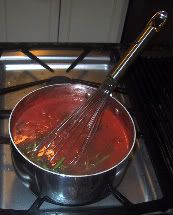 If you want to run with the big cooks you gotta learn to make veal stock as veal stock is the perfect canvas to illustrate a sauce onto. Veal stock is rich although by itself seems neutral. When it is the base of a sauce, though, it makes the flavors of the sauce pop.
If you want to run with the big cooks you gotta learn to make veal stock as veal stock is the perfect canvas to illustrate a sauce onto. Veal stock is rich although by itself seems neutral. When it is the base of a sauce, though, it makes the flavors of the sauce pop.I don't like stocks that are in boxes and cans at the grocery store for many reasons pertaining to healthy eating. I especially don't like them since they seem devoid of what makes stock magical in a sauce: GELATIN! To get the best flavor and texture in my stock, I make from scratch. I make gallons of chicken stock particularly in the summer when chicken appears as our entree frequently. Chicken stock is the most versatile stock for light soups and I love it in risotto and pasta. Veal stock, on the other hand, I make in small quantities since I buy the bones from my butcher specifically for stock making (for chicken stock I always have plenty of carcasses in my freezer because I buy whole chickens and de-bone them myself). The expense and scarcity of veal stock in my freezer means that we only use the stuff for special occasions.
This Saturday I am cooking for three other couples and us as our turn in the HDASA annual rotation. HDASA, "Hammered, Drunk, and Stupid Again", is our wine and food group. The odd name was chosen to make the point that we don't take ourselves too seriously. I think it was captured in a round table brainstorming when we all had drunk quite alot of really good cab which made the name reflect the condition we were in at the time. But I digress. I care a great deal about these folks, so I put my heart and soul into the meal whenever it rotates to our house. As part of the prep, I made a pot of veal stock that I will use in a sauce for the lamb shank with Cabernet sauce entree.
This stock started with three veal necks from the local butcher. Necks and other knuckles make excellent stocks because of all the connective tissue in the joints. The total weight of the three necks was about five pounds which is a good amount for my 8-quart stock pot (I make chicken stock in a 16-quart model).
Veal Stock
5 lbs veal necks or other joints
3 yellow onions cut into chunks
4 medium carrots cut oblique
6 outside celery stalks cut on a bias
2 leeks washed. Pale parts sliced length-wise. Some of the dark green leaves reserved for the bouquet de garni
1 bunch parsley
Bouquet de Garni
A selection of herbs and spices tied into a leek leaf bundle.
For this stock I chose two bay leaves, rainbow peppercorns, fresh rosemary, fresh thyme, fresh oregano, and fresh marjoram.
Method
I like to roast the bones for a richer, more complex stock.
Pre-heat oven to 375 degrees F
Spread vegetables in a roasting pan and set the veal on top of the vegetables.
Roast until the meat is golden (lighter color makes a lighter stock, darker makes a darker stock)
Place roasted meat in stock pot and fill the pot 3/4 with water that covers the meat.
Bring the stock to a slow boil and skim the scummy foam from the top.
Add the roasted vegetables and bouquet. Return to a slow boil, skim, and lower heat to a tremble. A tremble is barely a simmer. You see the occasional bubble at the surface of the stock. This allows the stock to develop without turning the vegetables to mush.
After three hours add the parsley and cook one hour more. Add water if it gets too low. As the bones break down they make room for reduction. When I finish I have about 1/2 to 2/3 of a pot loaded before straining.
It is important to cool a stock quickly to avoid souring the stock. I fill my sink 1/2 with cold water and place the stock pot into the water. I let the water continue to fill the sink until the pot is about to float or the sink overflow, whichever comes first. Stir the stock and the sink water simultaneously to speed heat transfer.
Once cool enough to hold your finger in the stock, start the straining process. I start by using a slotted spoon to scoop out bones and vegetables from the stock pot to a coarse strainer set over a mixing bowl or other pot. Press hard on solids. When the solids are removed from the stock I strain the stock through a fine-mesh china cap into the bowl, followed by a second strain back to the stock pot. I then put the strained stock into containers that will be set in the refrigerator overnight to "freeze" the fat. It is important to de-fat any stock and this is the most efficient way. The next day you skim the frozen fat off the stock. I use the fat for frying eggs.
 If you did a good job on the stock, the cold stock will be set like Jello, which is a protein-rich, low-fat goldmine. If you want demi-glace reduce the stock by 3/4.
If you did a good job on the stock, the cold stock will be set like Jello, which is a protein-rich, low-fat goldmine. If you want demi-glace reduce the stock by 3/4.Now, to make the peach ice cream dessert!






